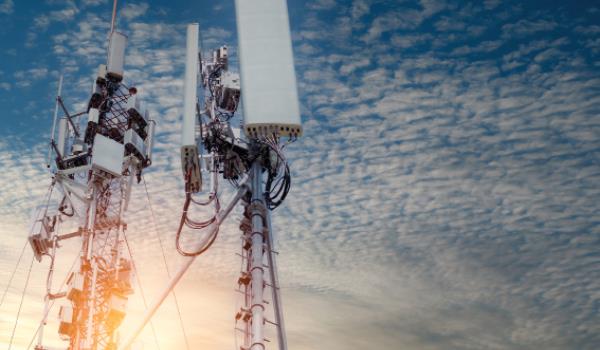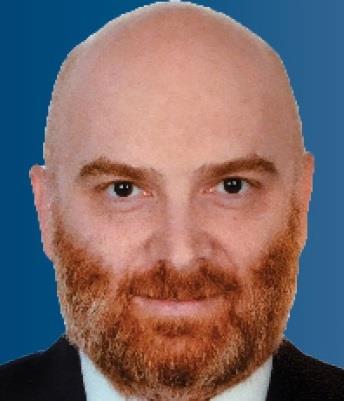06 October 2021

The fifth generation technology for broadband cellular networks, or 5G, is now available in selected cities around the world. But how is Africa preparing for it? Robert Shepherd investigates
According to the GSMA, the 2020s will see wide-spread deployment of 5G worldwide, including sub-Saharan Africa.
That might sound obvious – after all, it’s a natural progression from 4G and it’s already being used in other, more advanced and affluent parts of the world. However, it’s important to caveat that with the fact 5G arrival is unlikely to be imminent in most territories in the region, because the existing technologies are capable of supporting current use cases and overall demand for mobile internet connectivity.
When you think about it, the prospect of running a combined 2G/3G/4G in addition to a brand new 5G network is likely to pose an operational challenge to operators in the region. That’s due, in part, to the fact that initial deployment of 5G will face the complexity of managing legacy networks, the need to integrate legacy networks with the new 5G network - and the resources and expertise required to address these challenges.
In fact, some two-thirds of respondents to the GSMA’s 2019 report 5G in sub-Saharan Africa: laying the foundations, said they did not envisage commercial 5G services to be available before 2025.
Time to be clear what “5G services” means in this context.
“5G is one of the series of what are called; ‘transformative technologies’,” says Bulent Unsal, head of telco, EMEA south, SAP Middle East, the cloud business software company. “The others include ‘artificial intelligence’, ‘the cloud’, and ‘the internet of things’. These are said to be shaping tomorrow’s world, singly or together. In the simplest terms, 5G is a collection of tools that should allow ‘higher speed’ internet to be available by ‘wireless’ rather than by cables and phone lines brought into the home or office.”

Alessandro Ravagnolo, partner at TMT management consulting firm Analysys Mason
“The only difference with 5G is that energy and backhauling requirements may increase and operators/towercos need to make investments to support this. Apart from that, a mast continues being a mast”
Nevertheless, 5G will arrive in the next few years and that means the relevant technology needs to be in place. While the focus tends to be more on the speed of 5G, the cost and how it will benefit society as a whole – there has been much less talk on the technology supporting it and what the cellular towers need to make it a successful reality.
First and foremost, there’s cost. Introducing 5G in Africa, as well as the first phases of the rollouts - like anywhere else on Earth – will require hefty investment from mobile operators.
French giant Orange has long been a major player in Africa, with a solid presence in key Francophone nations. The company says 5G is very much a priority in terms of its African strategy and it explains why.
“We are starting to integrate 5G in the agenda,” says a spokesperson for Orange Middle East and Africa. “We think that in Africa, 5G could help relieve congestion on saturated mobile networks, particularly in densely populated capitals. We want to be able to launch this technology in our African markets by the end of 2022 and we are already trialing the technology. In 2020, we have demonstrated it in Egypt, Morocco and Senegal. And so far in 2021, we have conducted pilot operations in Egypt, Tunisia, Morocco, Côte d’Ivoire, Madagascar and more recently, Mali.
Orange says that while it is under no illusions as to the work involved. “Of course, such a technological change will require upgrades to our network, new investments and training for our people,” the spokesperson adds. “Above all, 5G will come very soon after 4G. It will be even more necessary that authorities implement a favourable framework and make frequencies, spectral resources and authorizations available. This is critical to a rapid roll out of 5G.”
While Orange did not comment on the cost it will have to swallow to make a success of 5G – perhaps it’s too early to say – the GSMA predicts operators continent-wide will need to pump US$60bn to boost their networks between 2018 and 2025 – a fifth of which will be on 5G infrastructure.
It’s no secret that the industry landscape to date has generally been shaped by infrastructure-based competition between operators, but the 5G era.
Will likely see the introduction of new models of network ownership, with private 5G networks likely to proliferate in some regions. Passive infrastructure sharing and the use of tower companies is already a feature in sub-Saharan Africa but will become more widespread, particularly to address some of the specific coverage challenges in the region.
Active network sharing has been shown to deliver much higher levels of both capex and opex savings compared to passive, resulting in the best outcomes for operators and society at large. Beyond the regulatory considerations, vendors and tower companies can.
Look to facilitate active sharing; for example, ensuring robust operating models are in place to support the relevant operators and network operations, as well as standardising equipment to facilitate interoperability.
However, it may surprise some to learn that “technically, there is no such thing like a 5G tower” – that’s according to Ravagnolo. “A tower (either be a rooftop or ground-based mast) is a passive element that can support anything that goes on top of it (e.g. antennas, transmission, FWA antennas, IoT, etc.),” he argues. “The only difference with 5G is that energy and backhauling requirements may increase and operators/towercos need to make investments to support this. Apart from that, a mast continues being a mast.”
Helios Towers, which has a presence all over Africa (Congo, Democratic Republic of the Congo, Ghana, Madagascar Malawi, Senegal, South Africa and Tanzania), says its markets “are quite far from 5G” as 3G connections only overtook 2G connections for the first time in 2019. “To-date we have not worked with many vendors on 5G, given its relative infancy in our markets,” says a company spokesman. “Even by 2025 <10% connections of our markets are expected to be 5G,” says a company spokesperson. However, Helios explains how it is working towards facilitating its arrival.

Bulent Unsal, SAP
“It will play a key role in transforming cities into smart cities, allowing citizens and communities to realise and participate in the socio-economic benefits delivered by an advanced, data- intensive digital economy”
“Operators tend to add additional antenna for 5G, so in some instances, we may need to strengthen the tower,” says the spokesperson. “Additionally, there tends to be a higher power requirement, which may alter how we configure our site power infrastructure.”
The Covid-19 pandemic has caused logistical and manufacturing delays in most industries, but Helios said it hasn’t suffered as a result. “In 2020, we delivered >1,000 new tenancies in our markets, in-line with our guidance provided at the beginning of the year before the Covid impact,” adds the spokesperson. “In fact, we’ve seen a few operators call out they will be investing further in improving infrastructure, given data demand has accelerated significantly due to elevated home working.”
Ericsson, the Swedish gear-maker currently has 144 commercial 5G agreements, 82 publicly announced 5G contracts, and 94 live 5G networks, across Africa. Zoran Lazarevic, chief technology officer, Ericsson Middle East and Africa, says that while 2020 was touted as the year 5G deployments would go mainstream,Covid-19 did “upend” this. “However, the pandemic highlighted the importance of 5G as seen with the spike in demand for increased data speeds and network support,” he adds. “During the pandemic, we continued to help CSPs all evolve their networks to 5G and meet network deployment challenges through its Intelligent Site Engineering services. The services, which include several capabilities enabled by artificial intelligence (AI) and machine learning (ML) have made the delivery of networks more efficient and shortened the time to market.”
What’s more, Lazarevic argues that technologies like high-resolution cameras carried by drones and laser-scanning (used at places where drones cannot go, such as in no-fly zones and interiors) have helped make deployment more productive while also lowering the environmental impact of deployment. “They have also enabled the effective creation of digital twins, which provides technicians and engineers with highly accurate site data, allowing them to prepare and design the site for the new equipment installations,” he adds.

Jan Liebenberg, Nokia
“Through our range of intelligent site engineering services and smart solutions, we are on track to help CSPs’ all around the world roll out 5G extensively in the coming years.”
Fellow Nordic giant Nokia of Finland also has a strong presence in the region Jan Liebenberg, customer chief technology officer for southern Africa at Nokia, says telcos must get ready for the future of Radio Access Networks (RAN) to be prepared to take advantage of a surge in demand for new services and more services.
“Our customers will be looking at higher capacity and connectivity, scalability and future-proofness along with wider radio spectrum support, more intelligence with Artificial Intelligence (AI) and Machine Learning (ML), shared infrastructure and lower energy consumption,” says Liebenberg.
Alessandro Ravagnolo, partner at TMT management consulting firm Analysys Mason, argues that 5G is not expected to change the role of towercos in the value chain and they are expected to be an important element of it by offering colocation space and power.
“As such, their offering is not really changing,” he says. “However, there is a trend towards towercos expanding their asset perimeter and offering to become all-around digital infrastructure service providers. This trend was not kickstarted by 5G, but you can tell that 5G has accelerated in many ways this process. This is true for both developed and emerging economies. Actually, there are elements to suggest that we have seen more innovation in emerging economies where operators faced a challenging environment and capex shortage that led to more innovative solutions like more extensive adoption of coverage and power as service solutions.”

“Our customers will be looking at higher capacity and connectivity, scalability and future-proofness along with wider radio spectrum support, more intelligence with Artificial Intelligence (AI) and Machine Learning (ML), shared infrastructure and lower energy consumption”
Still, there is a common thought or belief that the tower sector will change as a result of 5G, in terms of the number, positioning and technology on the towers themselves.
However, this is not a view shared by Ravagnolo who says “there is a pre-concept” that 5G will implicitly mean more space on the tower, which is not necessarily true.
“The RAN technology has evolved and continues evolving,” he continues. “Vendors are making great effort towards reducing the wind-loading of their equipment (i.e. RF antennas and RRUs), which often balances out many additional space requirements from upgrading the site with new carriers / frequencies.”
For example, Ravagnolo says multi-band antennas are becoming increasingly available and cost effective, also in emerging markets. What can make the difference is the adoption of ‘so called’ massive MIMO antennas. “These are active antennas – nowadays most units are passive with the RRU functionalities being delivered through a separate box – and are typically deployed as separate units from the passive antennas delivering 2G-4G services,” he adds. “Although they are not large in size – in fact they are smaller than traditional antennas – they are thick and heavy, thus increasing the wind-loading and – depending on the contract - triggering revenue amendment opportunities for towercos. These antennas offer significant gains in terms of capacity and performance to operators.”
Nevertheless, Ravagnolo says “they are still expensive and we are seeing operators using them carefully” by deploying them in the most affluent and capacity-constrained areas. This means that not all sites will see this sort of equipment being deployed.
Ericsson delivers 5G RAN portfolio that consists of antennas, radios, baseband (RAN Compute) and RAN software to enable incredible speeds and mobility. It also offers a purpose-built portfolio and a Cloud RAN portfolio for 5G that offers CSPs flexibility when rolling out networks worldwide.
Zoran Lazarevic, chief technology officer, Ericsson Middle East and Africa, explains how the antenna system is in fact one of the most crucial areas in a radio access network. “As 5G sites add complexity with new frequencies (2G-5G) and multiple technologies (FDD-TDD), it increases the need for site optimisation,” he says. “Ericsson Antenna System is an integral part of Ericsson Radio System and provides a full range of high-quality products in the following areas: passive antennas, active antennas, filters and combiners, tower mounted amplifiers, feeder system, and accessories.”
Lazarevic adds that as the new performance demands on networks require new levels of spectral efficiency and flexibility, Ericsson, through its massive MIMO portfolio, offers a wide range of Antenna Integrated Radios for a maximum 5G experience and capacity. “The portfolio includes lightweight and energy-efficient options, combined with real-time beamforming capabilities supporting both TDD mid-bands and FDD bands.”

Zoran Lazarevic, Ericsson Middle East and Africa
“As 5G sites add complexity with new frequencies (2G-5G) and multiple technologies (FDD-TDD), it increases the need for site optimisation”
As Africa continues to invest in 5G, Unsal says it’s important to focus on what the “general impact of 5G on society could be going forward. He says 5G networks will bring three important capabilities which are enhanced mobile broadband (eMBB), massive machine-type communications (mMTC) and ultra-reliable and low-latency communications (URLLC).
“5G is an opportunity to empower citizens and businesses,” he says. “It will play a key role in transforming cities into smart cities, allowing citizens and communities to realise and participate in the socio-economic benefits delivered by an advanced, data- intensive digital economy.”
He adds that 5G promises to deliver improved end-user experience by offering new applications and services through gigabit speeds, and significantly improved performance and reliability. “5G will build on the successes of 2G, 3G and 4G mobile networks, which have transformed societies, supporting new services and new business models,” Unsal adds. “5G provides an opportunity for wireless operators to move beyond providing connectivity services, to developing rich solutions and services for consumers and industry across a range of sectors – and at affordable cost.”
Now, we might be jumping the gun a bit, but 6G has entered the modern technology lexicon.
While 5G is the technology of the moment, some parts of the world, namely the US and South Korea are already testing its successor. Although the launch of the technology is still some time off, the relevant technology will need to be in place. Or does it? “6G standard is still being developed, the expectation is that the bodies developing the standards will build 6G on the 5G base so that the investment in 5G is not wasted,” says the Helios spokesperson.
For Ravagnolo, RAN equipment typically has a useful lifetime of six-eight years – or a maximum of 10. “As such, it will need to be swapped before 6G comes,” he says.







